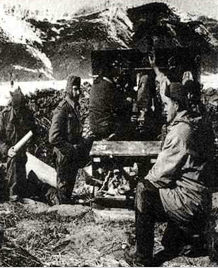 New Zealand
New Zealand
List for UN Allies
Background of Participation
Upon the resolution of the UN Security Council calling for
military assistance to South Korea, New Zealand dispatched two
frigates, the Pukaki and Tutira, which were attached to the US
Far East Navy. In addition, as the UN Secretary-General asked
for sending ground forces, the New Zealand government decided to
dispatch an artillery unit at the end of July.
On
November 26th, New Zealand established the 16th Artillery
Regiment, composed of 38 officers and 640 soldiers. The main
artillery of the regiment was British made 25 pound cannons,
which were similar to 105mm howitzers. The 16th Artillery
Regiment arrived in Pusan on December 31, 1950.
The Activity of the Ground Forces
The 16th Artillery Regiment moved to Janghowon and was attached to the British Commonwealth 27th Brigade on January 20, 1951. The regiment participated in counterattack operation on February 21st. Because of narrow roads and perilous landscape, it had difficulties in moving equipment and ammunitions. Nevertheless, the regiment advanced to the Kansas Line on April 16th.
As CCF launched an all-out offensive on April 22nd, the regiment withdrew to Kapyongchon, northeast of Kapyong. During the night, Chinese forces attempted to advance to Kapyong. The 16th Regiment deterred it by firing 10,000 rounds of howitzers for three days, causing numerous Chinese casualties.
On July 28th, the New Zealand regiment was attached to the newly established British Commonwealth 1st Division directly in support of the British Commonwealth 28th Brigade. The regiment supported the 28th Brigade in carrying out Operation Commando in attack of Mt. Kowang, Hill 217, and Mt. Maryang. In this operation, the artillery unit fired 72,000 shells. On November 4th, as CCF attacked the 28th Brigade in order to recover Hill 217. The regiment supported the Brigade by firing 10,000 shells for 24 hours. As the front was in a lull situation during February 1952, the regiment fired a number of propaganda shells containing bills and cartoons supporting psychological warfare. On October 23rd, the regiment supported the Canadian 25th Brigade on Mt. Kowang, which had been attacked by CCF. In this battle, the artillery regiment fired 50,000th shell of 25 pound cannons. On December 11th, as Chinese forces attacked the Hills of Nori and Betty, outposts of the ROK Army 1st Division, the artillery regiment supported ROK Army? counterattack by firing 3,400 shells.At the end of January 1953, the 16th Artillery Regiment was attached to the US 2nd Division. It began to support the 9th Regiment of the division. On March 17th, Chinese troops launched a surprise attack on Mt. Kowang. This fighting lasted 10 hours. The artillery unit fired 4,600 shells, assisting the 9th Regiment in securing Mt. Kowang. During May, as Chinese forces launched concentrated attacks on Hill Hook, the artillery regiment supported the 29th Brigade in defending the hill. On June 25th, as the ROK Army 1st Division engaged in a fierce combat with Chinese forces on Hill Pak and the Hill 179, the New Zealand regiment supported the South Koreans. It was the last combat fought by the regiment in Korea.
Activity of the Navy
From August 1, 1950, the two frigates of New Zealand, protected transport ships to Pusan. This operation of protecting continued until the beginning of September. During the Inchon landing, they were attached to the 7th Task Fleet to cover warships.
In early March 1951, the two frigates, joining with two South Korean sweepers, completed the mission of mine sweeping on the sea near Baekryong Island. This was accomplished despite bad weathers and the severe difference between the rise and fall of the tide. On May 18th, the New Zealand frigates discovered the enemies shore artillery position while patrolling between Cho Island and Sok Island, and destroyed it with 29 shells. When the British Marine launched a surprise attack on the enemies coastal artillery unit in Sogog-ri, south of Cho Island on August 25th, seven crew of the New Zealand vessel participated in this operation.
In the middle of February 1952, the Taupo was dispatched to the East Sea near Yang Island. On February 19th, when the enemy boarding 15 sailboats attacked the Yang Island, the Taupo destroyed 10 of the sailboats. While chasing the enemies sailboats, it was attacked by the enemies shore artillery. It retreated with some damage under cover by US warships.
On April 25, 1953, the Kaniere on the Yellow Sea launched counter-fire on the enemies coastal artillery positions, which had attacked US mine sweepers, thoroughly destroying them. After the armistice, the A total of 5,144 New Zealand soldiers participated in the Korean War. Among them, 23 were killed and 79 wounded. After the armistice, the Navy withdrew from Korea in March 1954, and the Army on November 11th.

